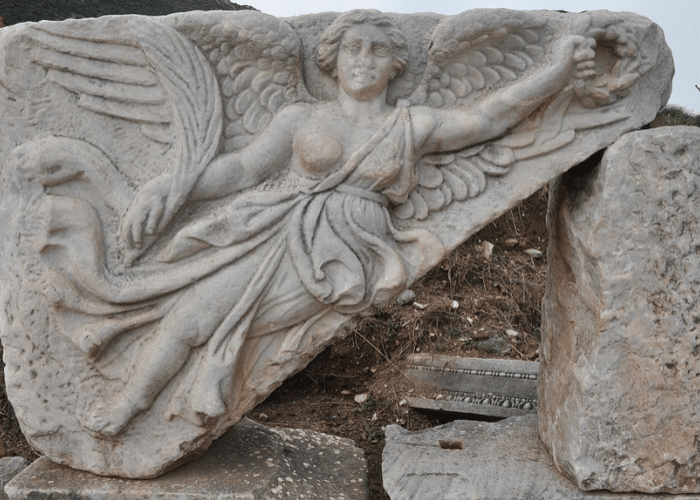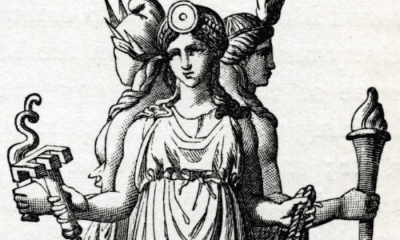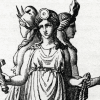
Greek
How Was Aphrodite Born?
How Was Aphrodite Born?
Did you know that the goddess of beauty was born from an act of ugly violence? Read on to learn about the strange circumstances of Aphrodite’s creation, and what it tells us about the goddess’s ancient origins!
The Greek goddess of beauty and love was born in a most unusual way.
When the primordial god of the heavens, Uranus, was castrated by his son, his genitals were carelessly tossed into the ocean. There, they interacted with sea foam and amazingly gave rise to the most beautiful goddess of the Greek pantheon.
The story of how Aphrodite was born may seem so unusual that it must be entirely unique, but it is in fact one of the many parallels between the Greek goddess and one of the ancient Near East.
The unusual story of Aphrodite’s birth gives historians some of their greatest evidence for the theory that Aphrodite was originally a Semitic goddess who was imported to the region by Phoenician traders early in Greek history.
The Unusual Birth of Aphrodite
The most commonly told story of the birth of Aphrodite is one of the most unusual in Greek mythology.
The origin story of the goddess of beauty began with the estrangement of Uranus and Gaia. The primordial deities of the heavens and earth had come together to create the Titans, but their relationship soured when Uranus imprisoned their less physically perfect children.
Gaia implored her sons to intercede and take their father’s power for his mistreatment of their monstrous looking brothers. Only the youngest of the Titans, Cronos, was willing to move against his father.
He and Gaia came up with a plan to attack Uranus when he was most vulnerable. The next time the god of the heavens descended to mate with the earth, Cronus attacked him with an adamantine sickle.
Cronos castrated his father, leaving Uranus weak and unable to make more children with Gaia. He threw his father’s severed male organ into the sea as his brothers moved to forever separate the heavens and the earth.
The Titans took control of the universe from the once-powerful Uranus, with Cronos as their king.
The drops of blood that fell from Uranus’s body to the earth produced the last children born to him from Gaia. They were the Erinyes, or Furies, and the ash-tree nymphs.
While the drops of blood gave rise to many offspring, the part of Uranus that had been tossed into the water created one more.
The last of Uranus’s power combined with the white foam of the sea. Over time, a shape began to take form in the water.
Aphrodite stepped out of the water on either the island of Cytheria or on Cyprus. She was extraordinarily beautiful and instantly welcomed by the other gods.
The last child of Uranus would be his most famous daughter. While the Titans were overthrown and their sisters largely faded from prominence, Aphrodite continued as the Olympian goddess of beauty.
My Modern Interpretation
The story surrounding Aphrodite is generally considered to be one of the oldest in Greek mythology. While ancient writers connected her name to the Greek term for sea foam, this folk etymology has now been largely discredited.
Instead, most historians agree that Aphrodite’s name predates the Greek language and may not even belong to a closely related culture.
One probable source for both Aphrodite and her birth myth is in the Anatolian Hittite culture. In The Song of Kumarbi, a Hittite poem from the 14th century BC, the titular god gave birth to a new generation of deities after biting off his father’s genitals, a story strikingly similar to the downfall of Uranus at his son’s hands.
One of the goddesses born from this event was Ishtar, also known as Astarte to the Phoenicians and Inanna to the Sumerians. This ancient goddess of love and beauty was similar to Aphrodite in both form and function.
The earliest known statues of Aphrodite in Greece are almost indistinguishable from Near Eastern depictions of Ishtar. Other artifacts from the time period show an influx of Phoenician material culture in the region, making it seem likely that Aphrodite’s cult was brought to the Greeks by traders from the east.
Many historians believe Aphrodite’s name to come from the Semitic languages of the ancient Near East, where Ishtar originated. The Phoenicians, who introduced their alphabet to the Greek world, likely brought their goddess of beauty as well.
Aphrodite and Ishtar alike were also connected to the ancient archetype of the dawn goddess. Some historians read the scene of Aphrodite rising out of the water as a holdover of this earlier archetype, comparing the image to that of the sun rising over the horizon.
Not all Greeks envisioned Aphrodite as rising from the sea foam that created her, however. Homer notably claimed that she was not a daughter of Uranus, but rather the child of Zeus and a goddess he called Dione.
In later works, Plato attempted to reconcile these two stories by claiming that they referred to separate goddesses, a “heavenly” Aphrodite and a “common” one.
Interestingly, Dione’s name seems to be a cognate of Dios, another name for Zeus himself. Seldom referenced elsewhere in literature, Dione’s name could signify a version of the story in which Zeus, rather than his grandfather, gave rise to Aphrodite without a proper maternal figure.
While Plato proposed a theory of two separate forms of Aphrodite, the unusual figure of Dione makes it seem very likely that Homer was influenced by a slight variation on the story of Aphrodite’s motherless birth.
The connection between Aphrodite and her Semitic counterpart is so strong that even the most sceptical historians find it to be compelling evidence that Greek culture was influenced by that of the Near East. It is now widely accepted that, sometime around the 8th century BC, Phoenician and Assyrian traders brought Aphrodite to Greek lands along with their material culture.
In Summary
Aphrodite, the Greek goddess of love and beauty, was said to have been born from the interaction of Uranus’s severed anatomy and white sea foam.
She stepped out of the water fully-grown and astoundingly beautiful. While Uranus’s other children fell from power, Aphrodite remained a central member of the new pantheon of Mount Olympus.
The unusual tale closely resembles another from Turkey and the Near East. The goddess known in those regions as Ishtar, Inanna, or Astarte was one of the deities born when a ruling god was castrated by his son as well.
In addition to similar iconography and functions in their pantheons, both Aphrodite and her Eastern counterpart can be interpreted as variations on an ancient dawn goddess archetype. The image of Aphrodite emerging from the waves is seen as a remaining aspect of this type as it mirrors the way the sun rises over the eastern horizon in the morning.
Most modern scholars agree that Aphrodite arose from this Eastern goddess, likely brought to Greece by the same Phoenician traders that introduced writing to the Greek world.
While some writers claimed that Aphrodite was actually a daughter of Zeus, the unusual name of her supposed mother leads to an interpretation that this version of the story came from a similar tale of a goddess born from a male deity alone.



